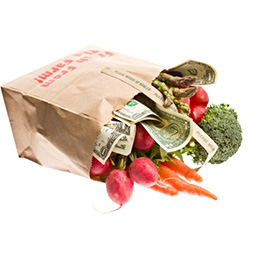Since the 1990’s consumer demand has grown by the double-digits every year. Organic sales increased from $3.6 billion in ’97 to over $39 billion in 2014. However, production is not keeping up with demand. Supply shortages are one of the greatest challenges facing the industry today. Despite continued growth in production, handlers are not able to keep up with demand. Organic food sales currently make up 4% of total food sales, while acreage devoted to organic agriculture is less than 1% of total U.S. cropland.
This brings us to the next question at hand… Why is Organic Food more expensive than conventional food? Well here they are in a nutshell:
- No Chemicals = More Labor: Conventional farmers use all of those chemicals and synthetic pesticides because they end up reducing the cost of production by getting the job done faster and more efficiently. Without them, organic farmers have to hire more workers for tasks like hand-weeding, cleanup of polluted water, and the remediation of pesticide contamination. The Organic Farming Research Foundation explained it well: “The organic price tag more closely reflects the true cost of growing the food: substituting labor and intensive management for chemicals, the health and environmental costs of which are born by society.”
- Demand Overwhelms Supply: As stated above, conventional farms have the farmland and the supply to keep costs down since manufacturers are able to reduce costs when producing a product in larger quantities.
- Higher Cost of Fertilizer for Organic Crops: Sewage sludge and chemical fertilizers might not be something you want in your food, but conventional farmers use them because they don’t cost much and are cheap to transport. Organic farmers eschew these inexpensive solutions in order to keep their crops natural and instead use compost and animal manure, which is more expensive to ship.
- Crop Rotation: Instead of using chemical weed-killers, organic farmers conduct sophisticated crop rotations to keep their soil healthy and prevent weed growth. After harvesting a crop, an organic farmer may use that area to grow “cover crops,” which add nitrogen to the soil to benefit succeeding crops. Conventional farmers, on the other hand, can use every acre to grow the most profitable crops. Because crop rotation reduces the frequency in which organic farmers can grow profitable crops, they’re unable to produce the larger quantities that are most cost-effective for conventional farmers.
- Post-Harvest Handling Cost: In order to avoid cross-contamination, organic produce must be separated from conventional produce after being harvested. Conventional crops are shipped in larger quantities since conventional farms are able to produce more. Organic crops, however, are handled and shipped in smaller quantities since organic farms tend to produce less, thus causing higher costs. Additionally, organic farms are usually located farther from major cities, increasing the shipping cost.
- Organic Certification: Acquiring USDA organic certification is no easy – or cheap – task. In addition to the usual farming operations, farm facilities and production methods must comply with certain standards, which may require the modification of facilities. Employees must be hired to maintain strict daily record-keeping that must be available for inspection at any time. And organic farms must pay an annual inspection/certification fee, which starts at $400 to $2,000 a year, depending on the agency and the size of the operation.
- Cost of Covering Higher Loss: Conventional farmers use certain chemicals to reduce their loss of crops. For example, synthetic pesticides repel insects and antibiotics maintain the health of the livestock. Since organic farmers don’t use these, their losses are higher, which costs the farmer more and increases the cost to the consumer. Additionally, without all the chemical preservatives added to conventional foods, organic foods face a shorter storage time and shelf life.
- Better Living Conditions for Livestock: Higher standards for animal welfare, also means more costs for organic farms. According to the Food and Agriculture Organization of the United Nations, organic feed for cattle and other livestock can cost twice as much as conventional feed.
- Organic Food Grows More Slowly: Time is money. Not only are organic farms typically smaller than conventional ones, but they also, on average, take more time to produce crops because they refrain from using the chemicals and growth hormones used by conventional farmers.
- Subsidies: Production-oriented government subsidies reduce the overall cost of crops. In 2008, mandatory spending on farm subsidies was $7.5 billion while programs for organic and local foods only received $15 million, according to the House Appropriations Committee.

